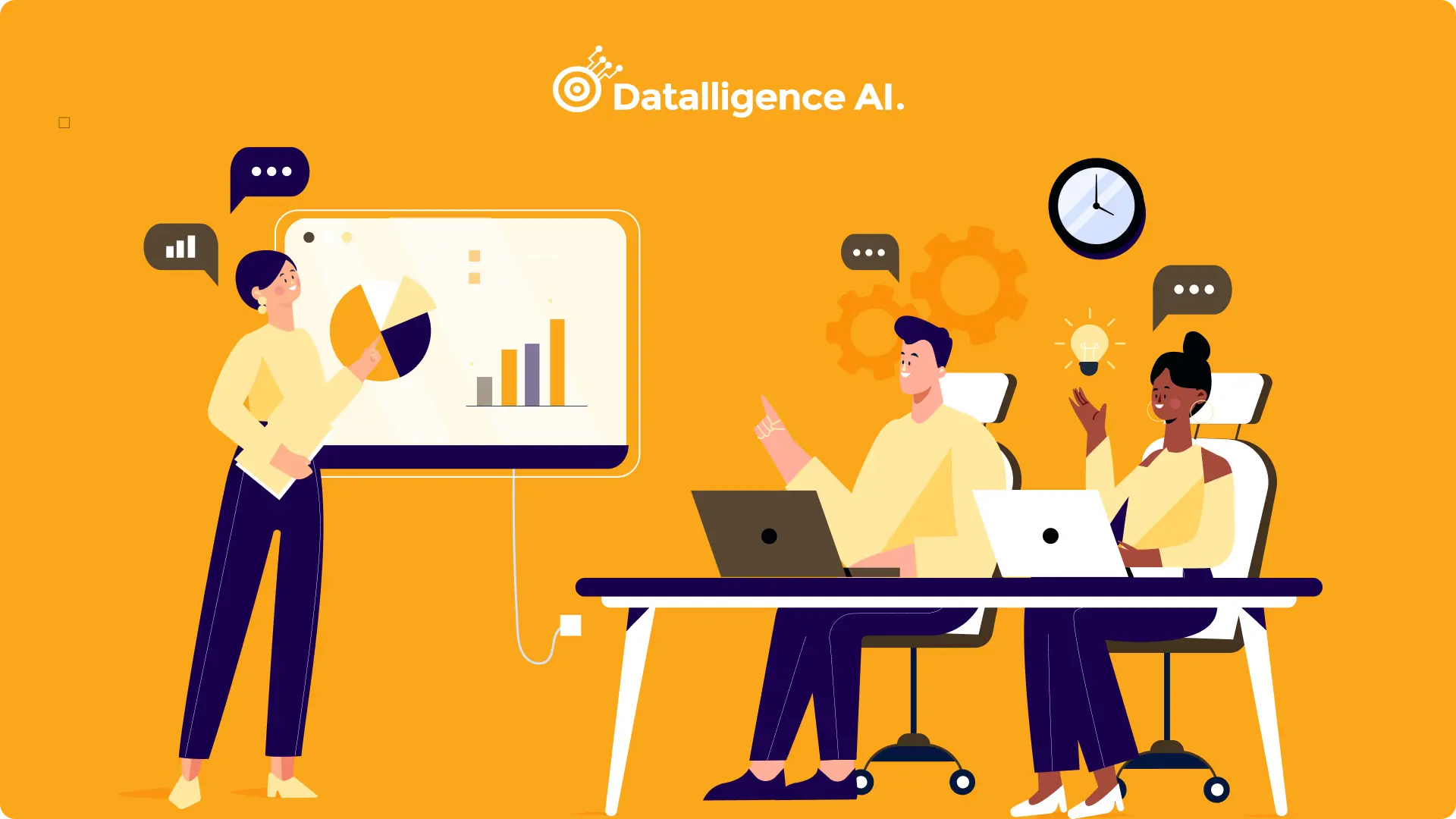As a project manager, setting clear and measurable performance goals is essential to achieving success. These goals help you stay on track and motivate your team to perform at their best. In this article, we’ll explore ten performance goals for project managers, with examples to help drive success in your projects.
One critical performance goal is ensuring effective communication. By fostering open, transparent communication channels, you can reduce misunderstandings, promptly address issues, and keep stakeholders informed throughout the project lifecycle. Leveraging an OKR Management Tool can further streamline this process, ensuring alignment and clarity within the team.
Another essential performance goal is managing project timelines. Setting realistic deadlines and proactively monitoring progress enables timely deliverables and helps avoid costly delays. Additionally, OKR SaaS Tools support project managers by centralizing key objectives, tracking progress, and aligning team efforts with project goals.
Why Performance Goals Are Important for Project Managers
Setting performance goals is a core aspect of effective project management. Without clear objectives, projects can easily become disorganized, leading to missed deadlines and overspending. Performance goals act as benchmarks, helping project managers measure progress and make informed decisions throughout the project lifecycle. An OKR Management Tool provides a structured approach to tracking and aligning these objectives, while OKR SaaS Tools offer the flexibility and accessibility needed for modern, agile project environments. By focusing on specific targets, project managers can ensure their teams remain aligned with the project’s vision, fostering a sense of purpose and direction.

Enhancing Project Delivery
Objective: Improve project delivery efficiency and effectiveness.
- Key Results 1: Reduce project delivery time by 10% compared to previous projects.
- Key Results 2: Achieve a 40% increase in on-time project completion.
- Key Results 3: Improve the project success rate by delivering 70% of projects within scope, time, and budget.

To achieve successful outcomes, project managers need to ensure efficient project delivery. In order to improve project delivery efficiency, managers should set clear goals and key results that are aimed at reducing the time of delivery, increasing on-time completion and keeping projects within scope, budget and time limits.
Maximizing Resource Utilization
Objective: Optimize resource allocation and utilization for improved project performance.
- Key Results 1: Increase resource utilization rate to 30% across all projects.
- Key Results 2: Achieve a 20% reduction in resource conflicts or bottlenecks.
- Key Results 3: Improve resource forecasting accuracy to within a 15% deviation.
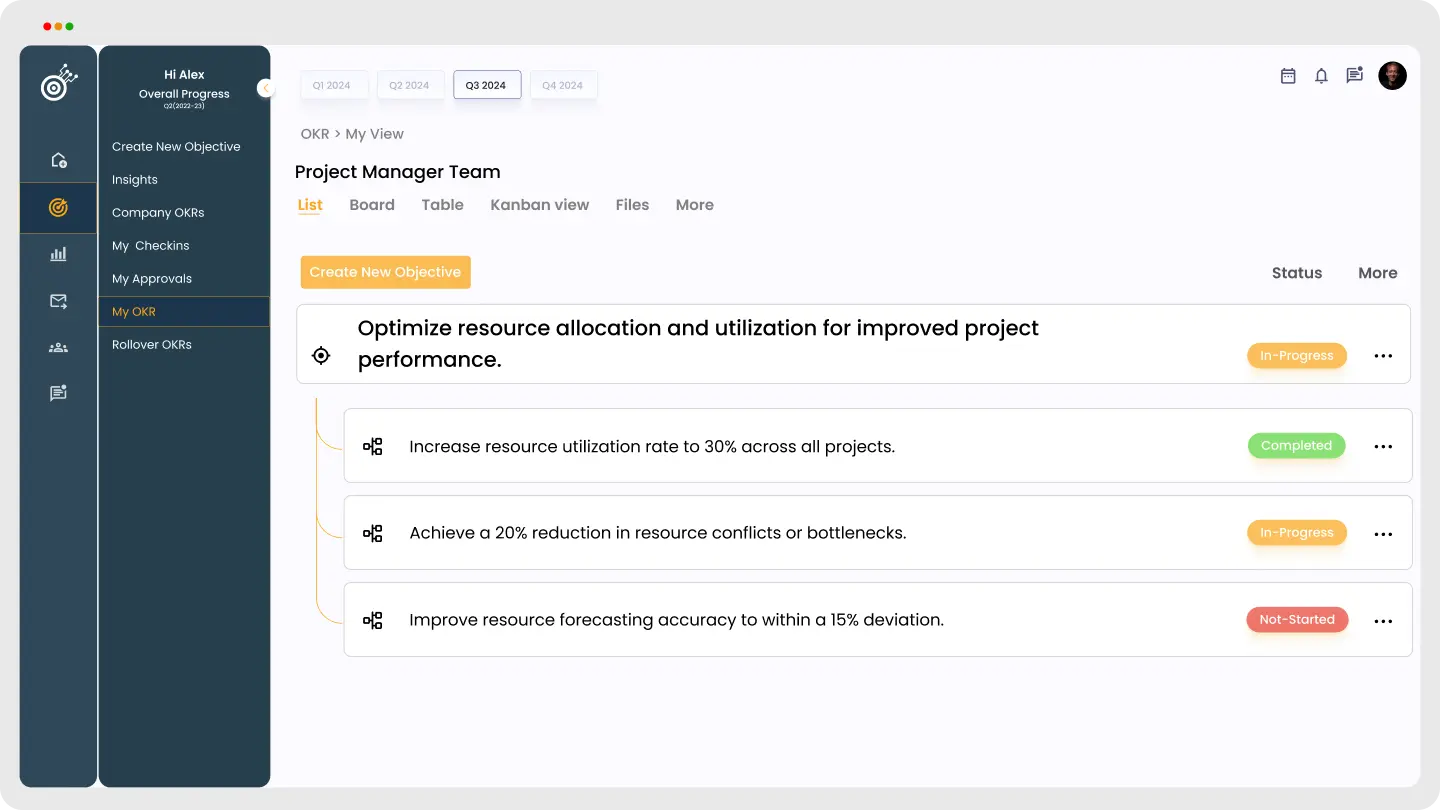
In order to achieve the maximum project performance, it is important to ensure that resources are effectively utilized. Project managers can set goals and key results that help enhance resource utilization ratios, eliminate any clashes or obstructions, and improve a prediction accuracy necessary for an efficient allocation of resources.
Strengthening Stakeholder Engagement
Objective: Enhance stakeholder engagement and satisfaction throughout the project lifecycle.
- Key Results 1: Conduct regular stakeholder meetings or feedback sessions with a 70% participation rate.
- Key Results 2: Achieve a 12% increase in stakeholder satisfaction scores.
- Key Results 3: Implement 20% of stakeholder suggestions or recommendations.

Project success dwells on the need to entangle stakeholders. Setting goals and objectives as well as key results in project management is based on regular meetings, improving stakeholder satisfaction, and implementing valuable suggestions or recommendations made by them to enhance stakeholder participation.
Improving Project Quality
Objective: better project quality and outcomes in order to meet or exceed customer expectations.
- Key Results 1: Increase customer satisfaction ratings for project deliverables by 10%.
- Key Results 2: Quality assurance measures will cut down on project defects or errors by 15%.
- Key Results 3: Improvement through the use of previous projects recommendations will be successful in 75% of cases.
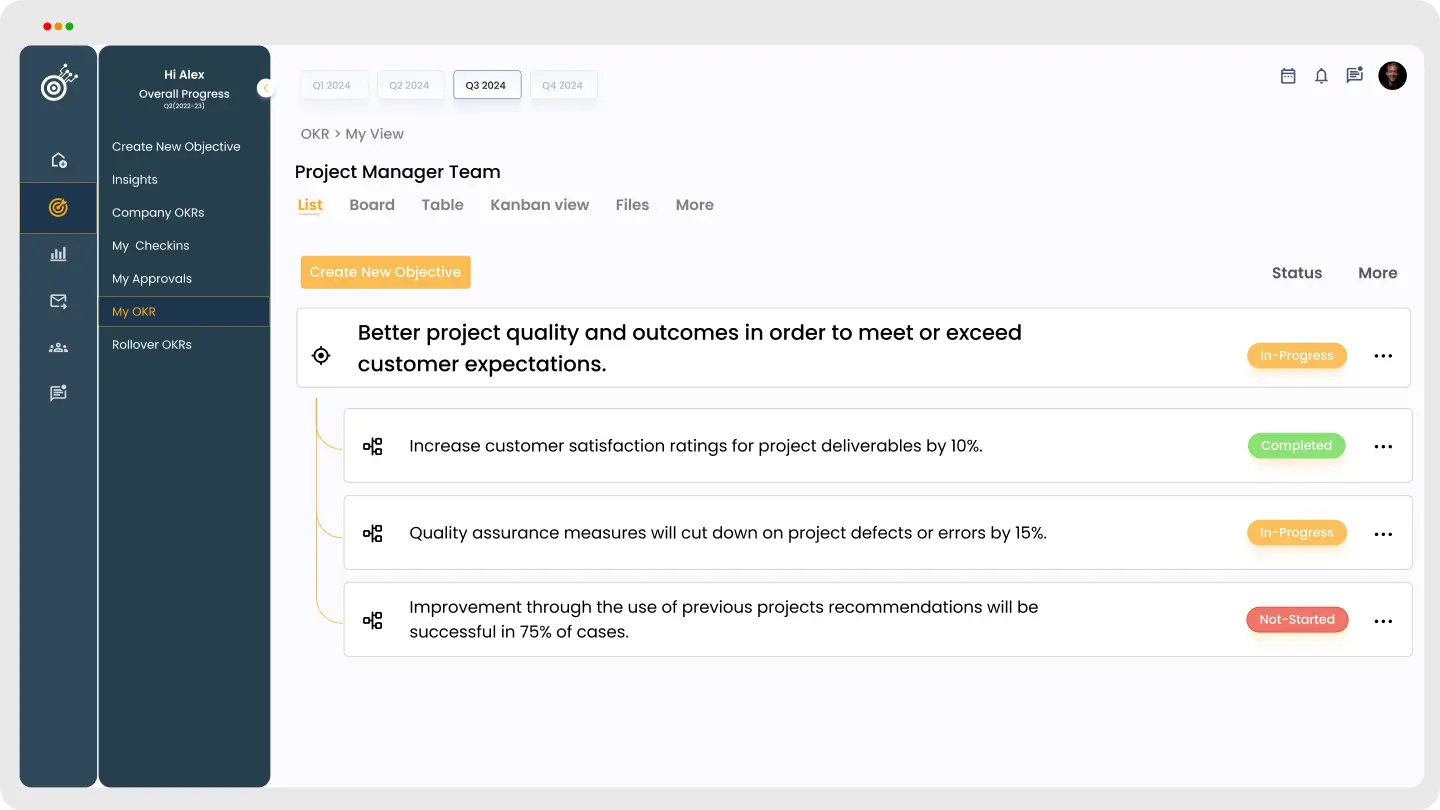
Customer satisfaction requires good project delivery. Goals and key results can be used by the project manager to increase customer satisfaction ratings, reduce defects/errors and implement lessons from previous projects to improve project quality.
Enhancing Risk Management
Objective: Strengthen risk identification, assessment, and mitigation strategies for projects.
- Key Results 1: Identify and assess 10% more project risks compared to previous projects.
- Key Results 2: Implement risk mitigation measures for 20% of identified high-priority risks.
- Key Results 3: Achieve a 30% reduction in project risks impacting timelines or outcomes.

Effective risk management is crucial for minimizing project disruptions. Project managers can set objectives and key results to improve risk identification, assessment, and mitigation strategies, ensuring that potential risks are identified, mitigated, and minimized to achieve project success.
Improving Communication and Collaboration
Objective: Enhance project team communication and collaboration for seamless execution.
- Key Results 1: Implement a project communication plan with a 40% improvement in team responsiveness.
- Key Results 2: Increase project team collaboration through 50% more effective use of collaboration tools.
- Key Results 3: Achieve a 30% reduction in project delays caused by communication or coordination issues.
Smooth communication and collaboration are vital for effective project execution. Project managers can set objectives and key results to implement a communication plan, improve collaboration through the effective use of tools, and reduce project delays caused by communication or coordination issues.

Enhancing Project Planning and Execution
Objective: Improve project planning and execution processes for better outcomes.
- Key Results 1: Develop and implement one standardized project planning template or methodology.
- Key Results 2: Achieve 20% adherence to project timelines and milestones.
- Key Results 3: Increase project team productivity by 70% through streamlined execution processes.
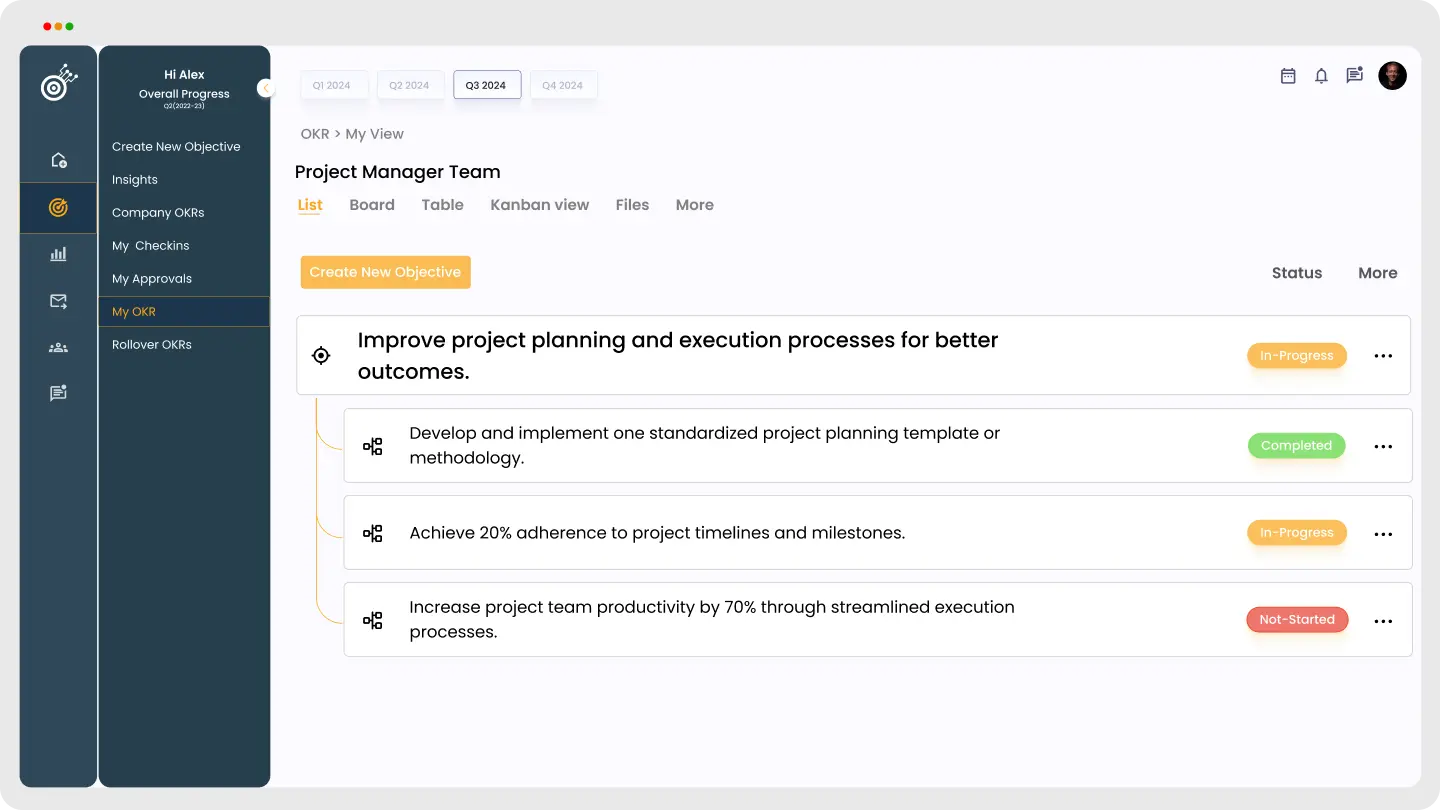
Efficient project planning and execution are crucial for successful project outcomes. Project managers can set objectives and key results to standardize planning processes, ensure adherence to timelines and milestones, and increase team productivity through streamlined execution processes.
Increasing Project ROI
Objective: Maximize project returns on investment and deliver tangible business value.
- Key Results 1: Achieve a 12% increase in project ROI compared to initial projections.
- Key Results 2: Deliver project outcomes that exceed customer expectations, resulting in 20% additional revenue.
- Key Results 3: Achieve 15% cost savings or operational efficiencies through successful project implementations.
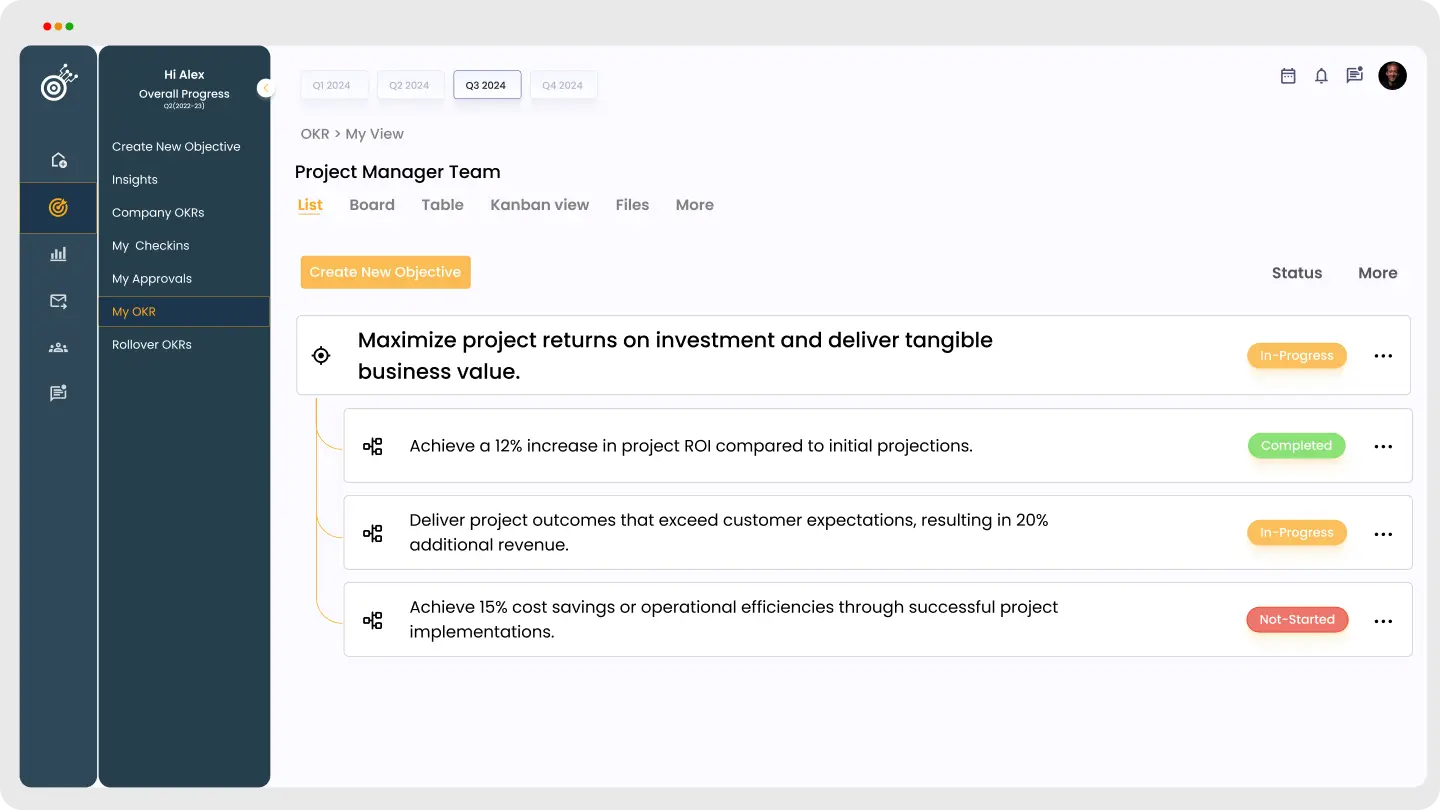
Maximizing project ROI is essential for business success. Project managers can set objectives and key results to increase ROI, deliver outcomes that exceed customer expectations, and achieve cost savings or operational efficiencies through successful project implementations.
Enhancing Change Management
Objective: Improve change management practices to ensure smooth project transitions.
- Key Results 1: Develop and implement a change management framework or process for 30% of projects.
- Key Results 2: Achieve 80% employee adoption and acceptance of project-related changes.
- Key Results 3: Reduce change-related resistance or conflicts by 15% through effective change management strategies.
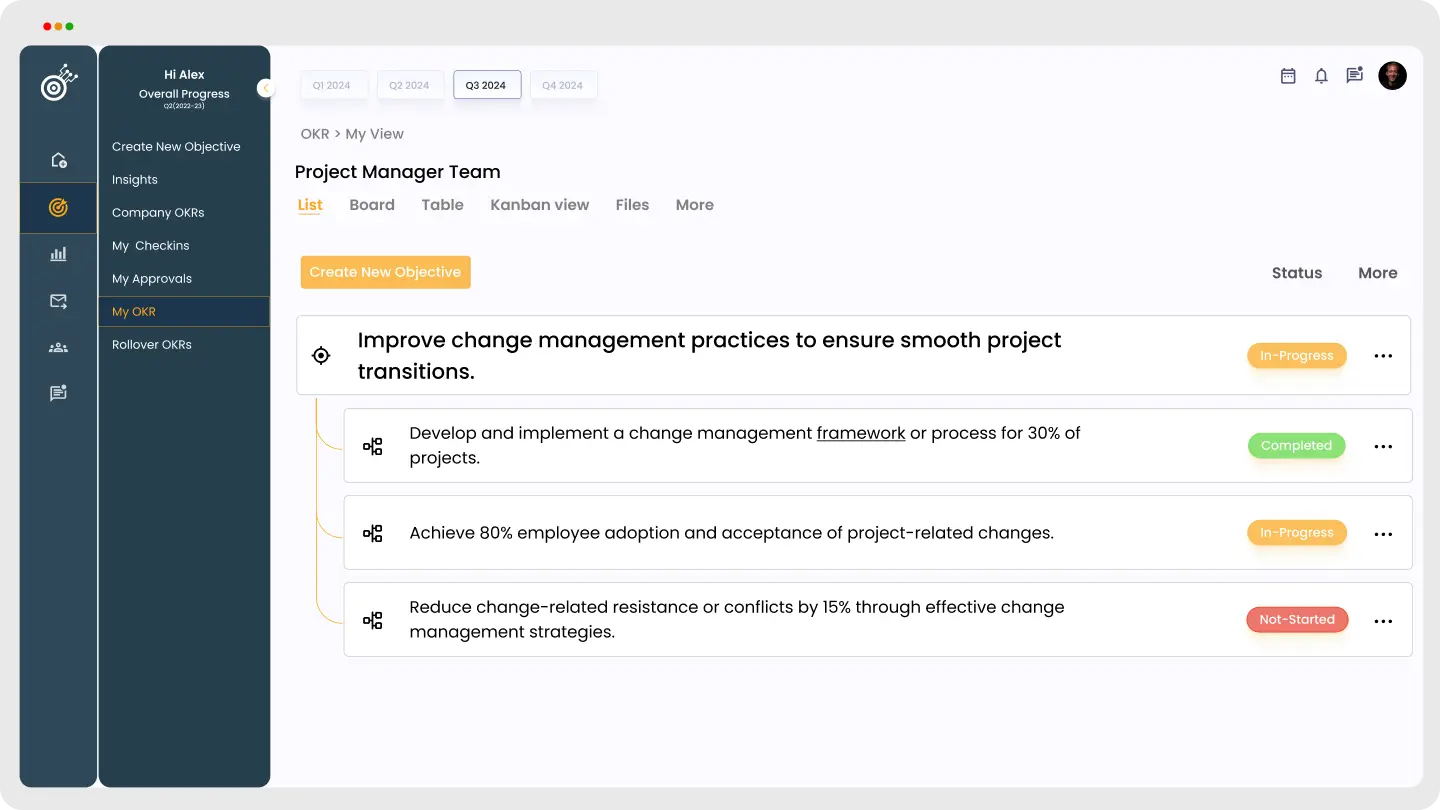
Effective change management is critical for successful project transitions. Project managers can set objectives and key results to develop and implement change management frameworks, ensure employee adoption of changes, and reduce resistance or conflicts through effective change management strategies.
Investing in Project Management Excellence
Objective: Foster the growth and development of project management professionals.
- Key Results 1: Provide project management training or certification opportunities to 60% of the project team.
- Key Results 2: Implement three knowledge sharing platforms or practices to facilitate project management best practices.
- Key Results 3: Achieve a 9 score on employee satisfaction with project management support and career development initiatives.
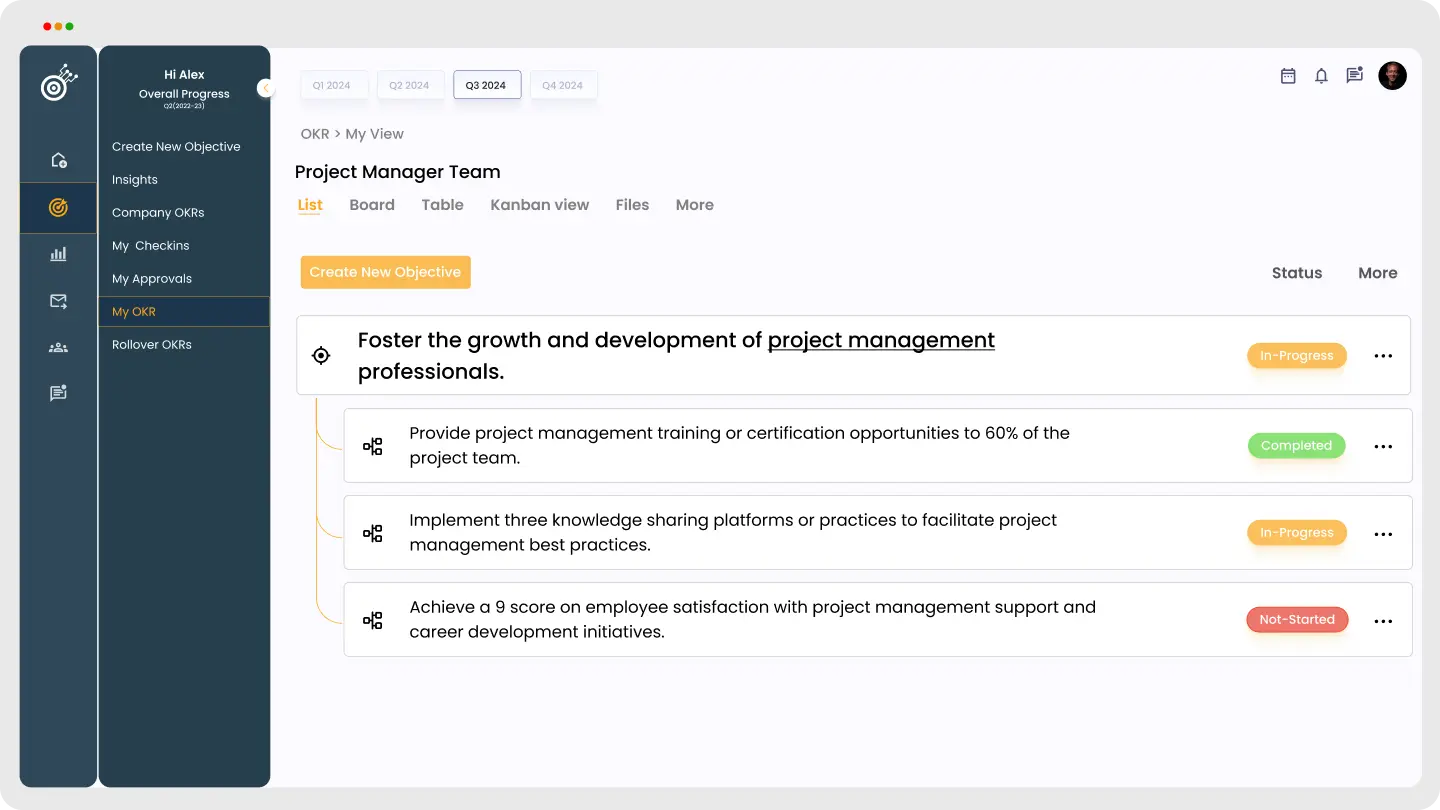
Investing in project management excellence is vital for continuous improvement. Project managers can set objectives and key results to provide training and certification opportunities, implement knowledge sharing platforms, and ensure employee satisfaction with project management support and career development initiatives.
Driving Innovation
Objective: Foster a culture of innovation within project management practices.
- Key Results 1: Implement at least two innovative project management techniques or tools.
- Key Results 2: Encourage and track the implementation of project team ideas for process improvement.
- Key Results 3: Achieve a 20% increase in the number of successful project innovations.
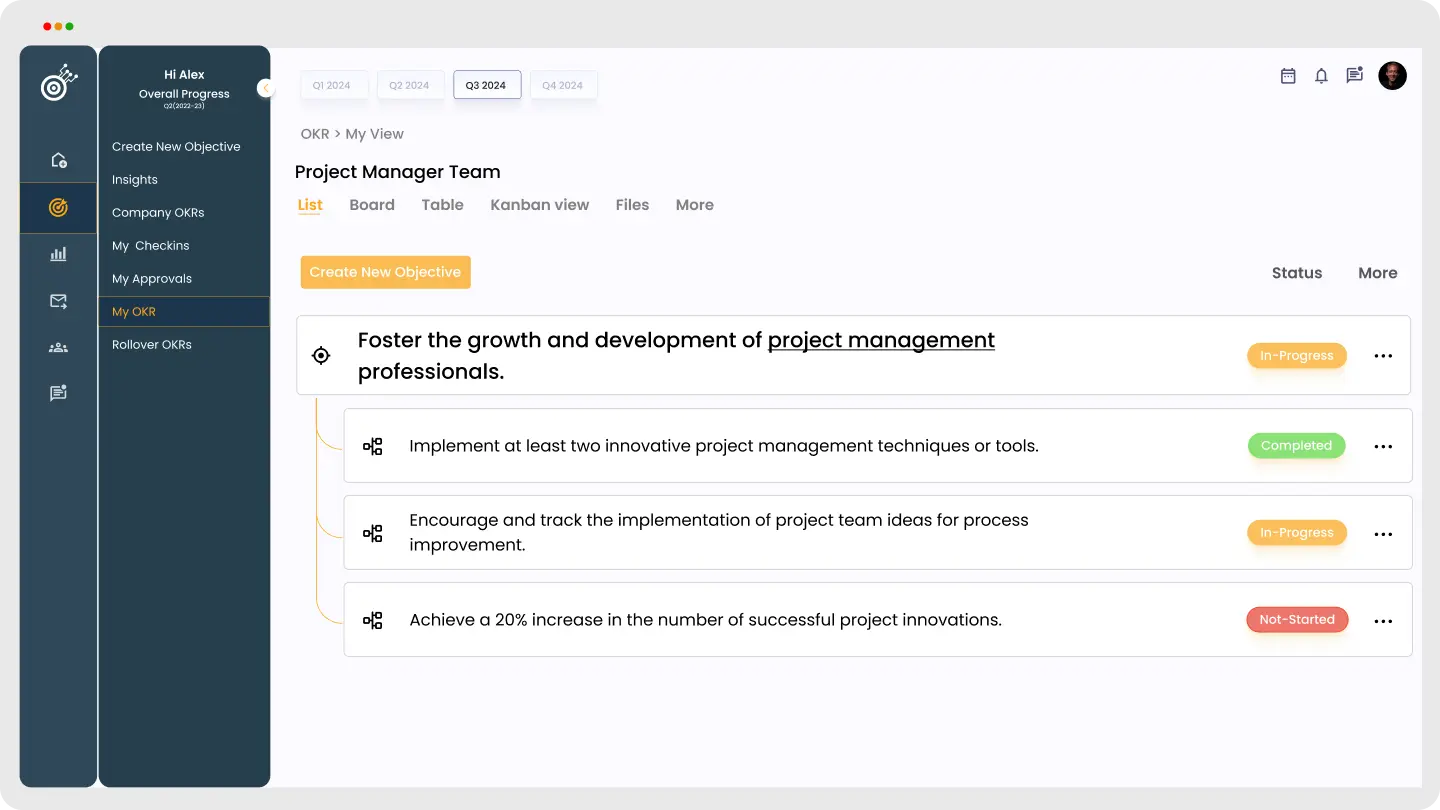
Driving innovation in project management practices can lead to improved outcomes. Project managers can set objectives and key results to implement innovative techniques or tools, encourage process improvement ideas from the project team, and measure the increase in successful project innovations.
Streamlining Project Documentation
Objective: Simplify project documentation processes for increased efficiency.
- Key Results 1:Reduce the average time spent on project documentation by 15%.
- Key Results 2:Implement a centralized project documentation repository for easy access and collaboration.
- Key Results 3:Achieve a 30% reduction in project documentation errors or discrepancies.

Efficient project documentation processes contribute to streamlined project management. Project managers can set objectives and key results to reduce the time spent on documentation, implement centralized repositories for easy access and collaboration, and minimize errors or discrepancies in project documentation.
Improving Cross-Functional Collaboration
Objective: Enhance collaboration between cross-functional teams for seamless project execution.
- Key Results 1:Conduct regular cross-functional team meetings with a 70% participation rate.
- Key Results 2:Increase the number of successful cross-functional projects by 20%.
- Key Results 3:Implement collaborative tools or platforms to facilitate cross-functional communication and coordination.
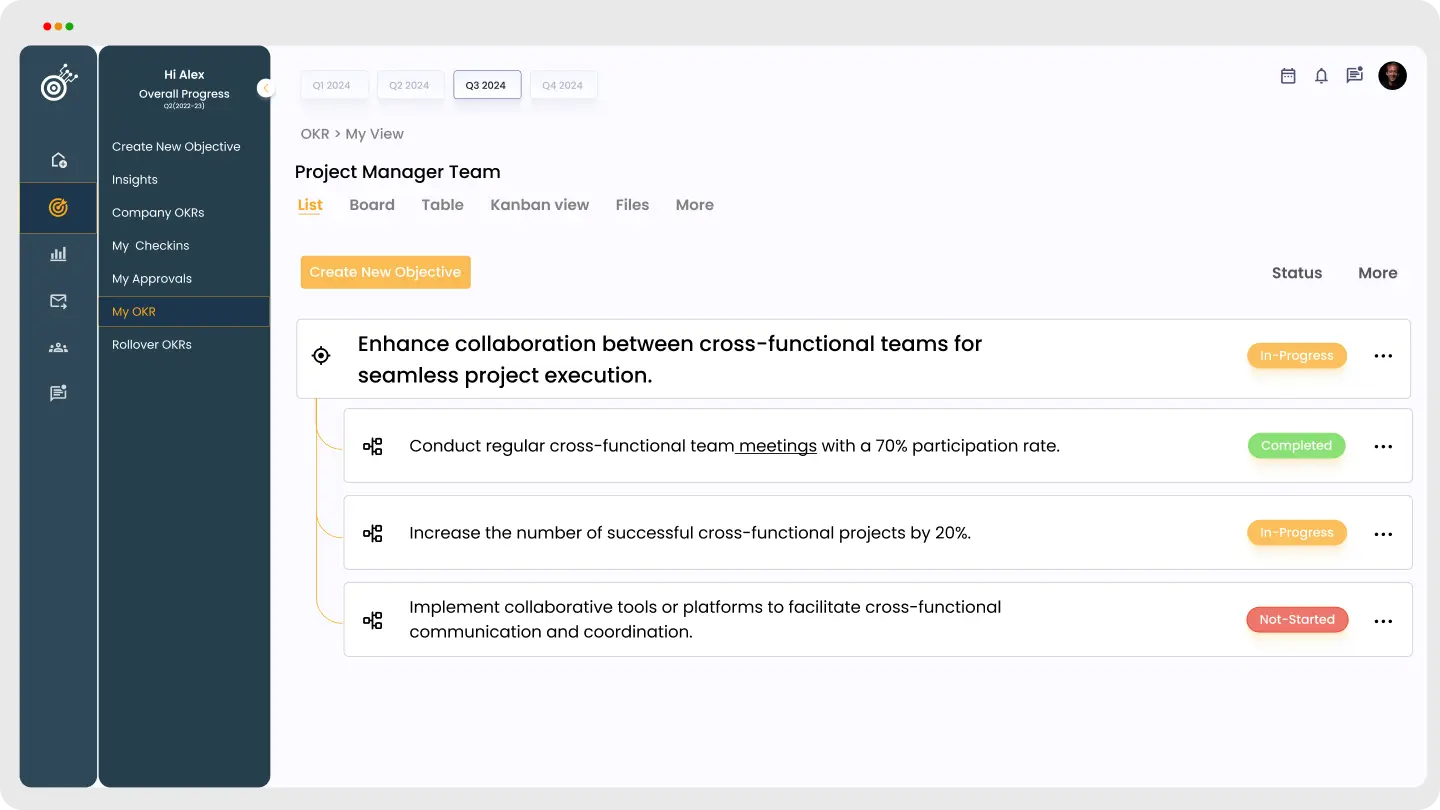
Effective cross-functional collaboration is vital for project success. Project managers can set objectives and key results to conduct regular team meetings, increase the number of successful cross-functional projects, and implement tools or platforms to improve communication and coordination among teams.
Enhancing Team Performance
Objective: Improve overall project team performance and productivity.
- Key Results 1: Provide training or professional development opportunities to 80% of the project team.
- Key Results 2: Implement performance feedback and recognition programs for project team members.
- Key Results 3: Achieve a 15% increase in team productivity based on project deliverables.

Optimizing team performance is crucial for project success. Project managers can set objectives and key results to provide training and development opportunities, implement feedback and recognition programs, and measure productivity improvements based on project deliverables.
Optimizing Project Scheduling
Objective: Optimize project scheduling for improved efficiency and on-time delivery.
Key Results:
- Key Results 1: Reduce project scheduling conflicts or overlaps by 20%.
- Key Results 2: Achieve a 90% adherence to project timelines and milestones.
- Key Results 3: Improve project scheduling accuracy to within a 5% deviation.
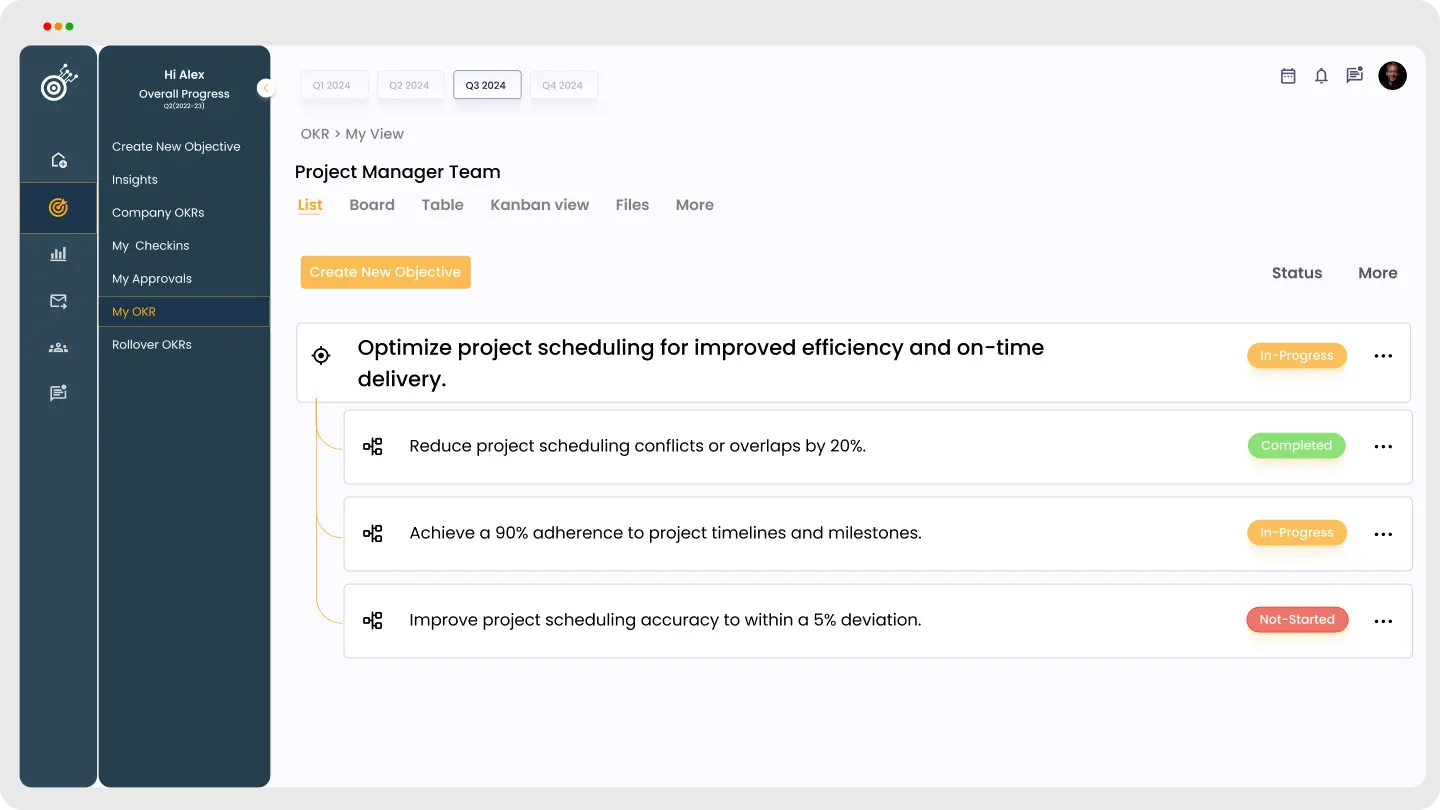
Efficient project scheduling is essential for ensuring on-time delivery. Project managers can set objectives and key results to minimize scheduling conflicts, ensure adherence to timelines and milestones, and improve scheduling accuracy for seamless project execution.
Ensuring Regulatory Compliance
Objective: Ensure compliance with relevant regulations and standards throughout the project.
- Key Results 1: Implement processes to monitor and track regulatory compliance for all projects.
- Key Results 2: Achieve a 95% compliance rate with relevant regulations and standards.
- Key Results 3: Conduct regular internal audits to identify and address compliance gaps.

Compliance with regulations and standards is critical for project success. Project managers can set objectives and key results to implement monitoring processes, achieve high compliance rates, and conduct internal audits to identify and address any compliance gaps.
Increasing Customer Satisfaction
Objective: Enhance customer satisfaction with project deliverables and outcomes.
- Key Results 1: Achieve a customer satisfaction rating of 90% or higher for project deliverables.
- Key Results 2: Implement a feedback mechanism to gather customer input and incorporate it into project improvements.
- Key Results 3: Increase the number of customer referrals or positive testimonials by 25%.

Customer satisfaction is a key measure of project success. Project managers can set objectives and key results to achieve high customer satisfaction ratings, gather customer feedback for continuous improvement, and increase referrals or positive testimonials from satisfied customers.
Enhancing Data Security
Objective: Strengthen data security measures throughout the project lifecycle.
- Key Results 1: Implement encryption protocols for sensitive project data.
- Key Results 2: Conduct regular security audits to identify and address vulnerabilities.
- Key Results 3: Achieve compliance with relevant data protection regulations and standards.
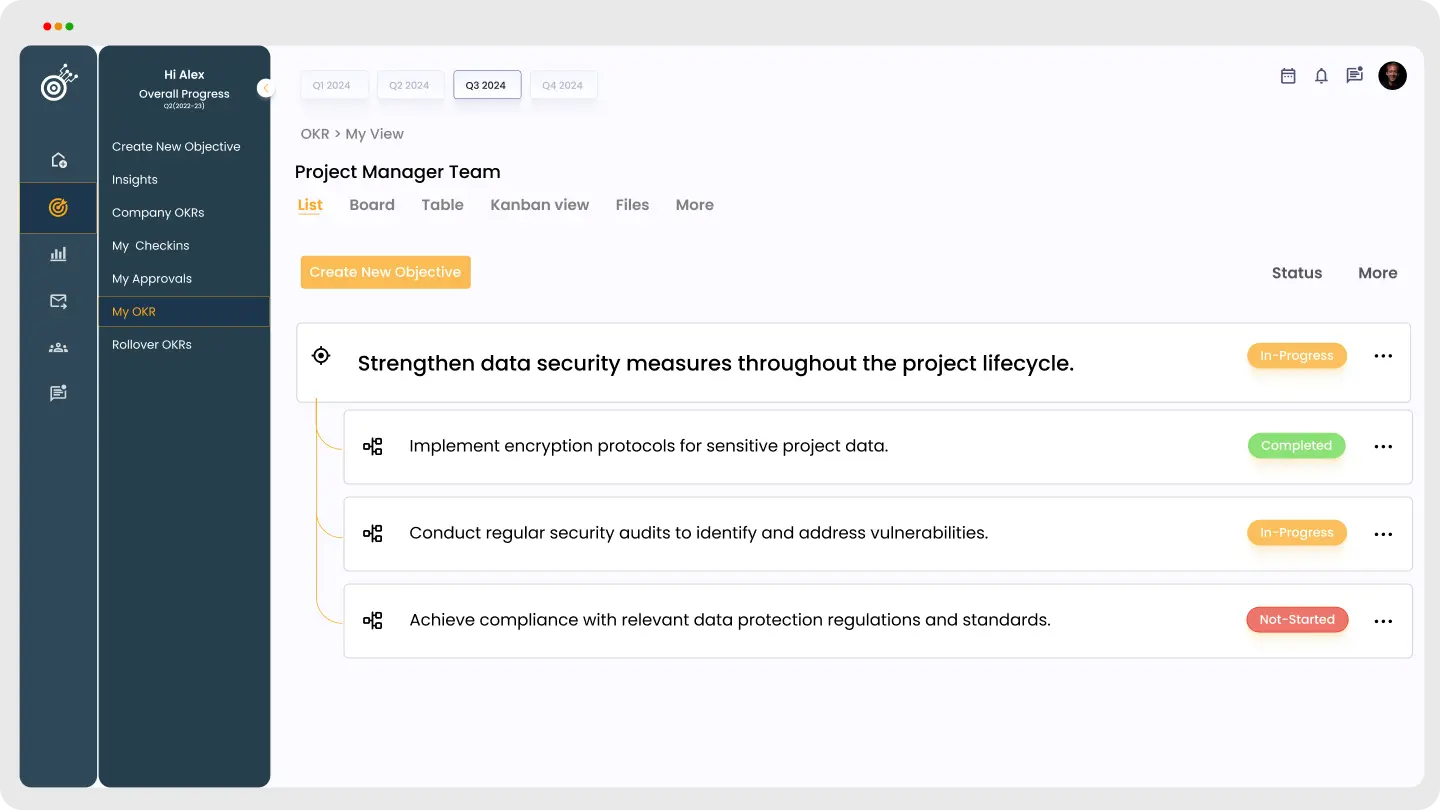
Data security is crucial for protecting project information. Project managers can set objectives and key results to implement encryption protocols, conduct security audits, and ensure compliance with data protection regulations and standards for enhanced data security.
Improving Vendor Management
Objective: Enhance vendor management practices for smooth project collaborations.
- Key Results 1: Conduct regular vendor performance evaluations with a 90% completion rate.
- Key Results 2: Achieve a 20% reduction in vendor-related issues or conflicts.
- Key Results 3: Implement vendor feedback mechanisms to gather input for process improvements.

Effective vendor management is essential for successful project collaborations. Project managers can set objectives and key results to evaluate vendor performance, reduce issues or conflicts, and implement feedback mechanisms to improve vendor relationships and processes.
Promoting Sustainable Practices
Objective: Integrate sustainable practices into project management processes.
- Key Results 1: Reduce project waste or environmental impact by 30%.
- Key Results 2: Implement sustainable procurement practices for project materials.
- Key Results 3: Achieve a sustainability certification or recognition for project management practices.
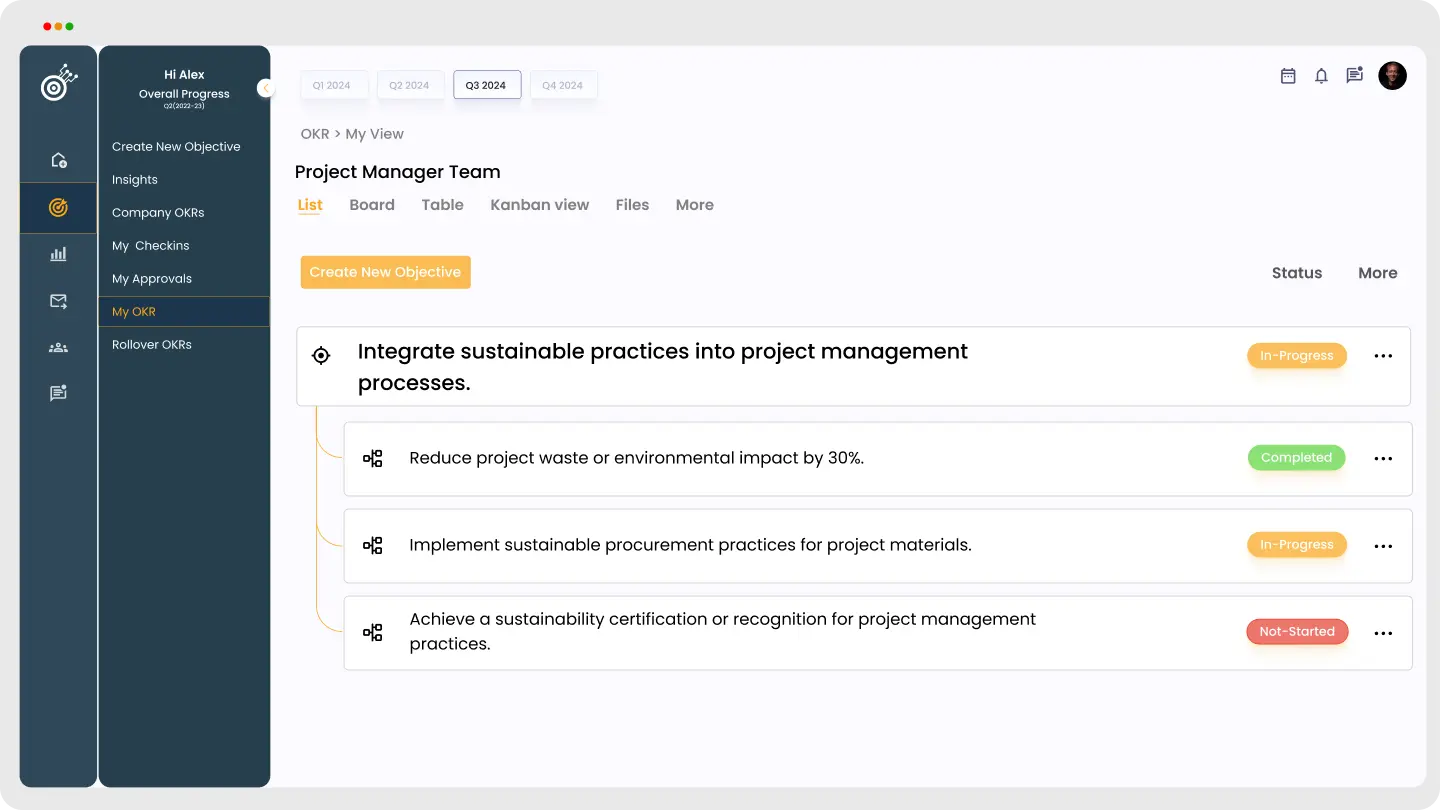
Promoting sustainability in project management contributes to environmental responsibility. Project managers can set objectives and key results to minimize waste or environmental impact, implement sustainable procurement practices, and strive for sustainability certifications or recognition to promote sustainable project management.
Strengthening Team Morale
Objective: Boost team morale and engagement for better project outcomes
- Key Results 1: Increase team satisfaction scores by 15%
- Key results 2: Implement 3 new team-building activities
- Key Results 3: Achieve a 20% improvement in team retention rates
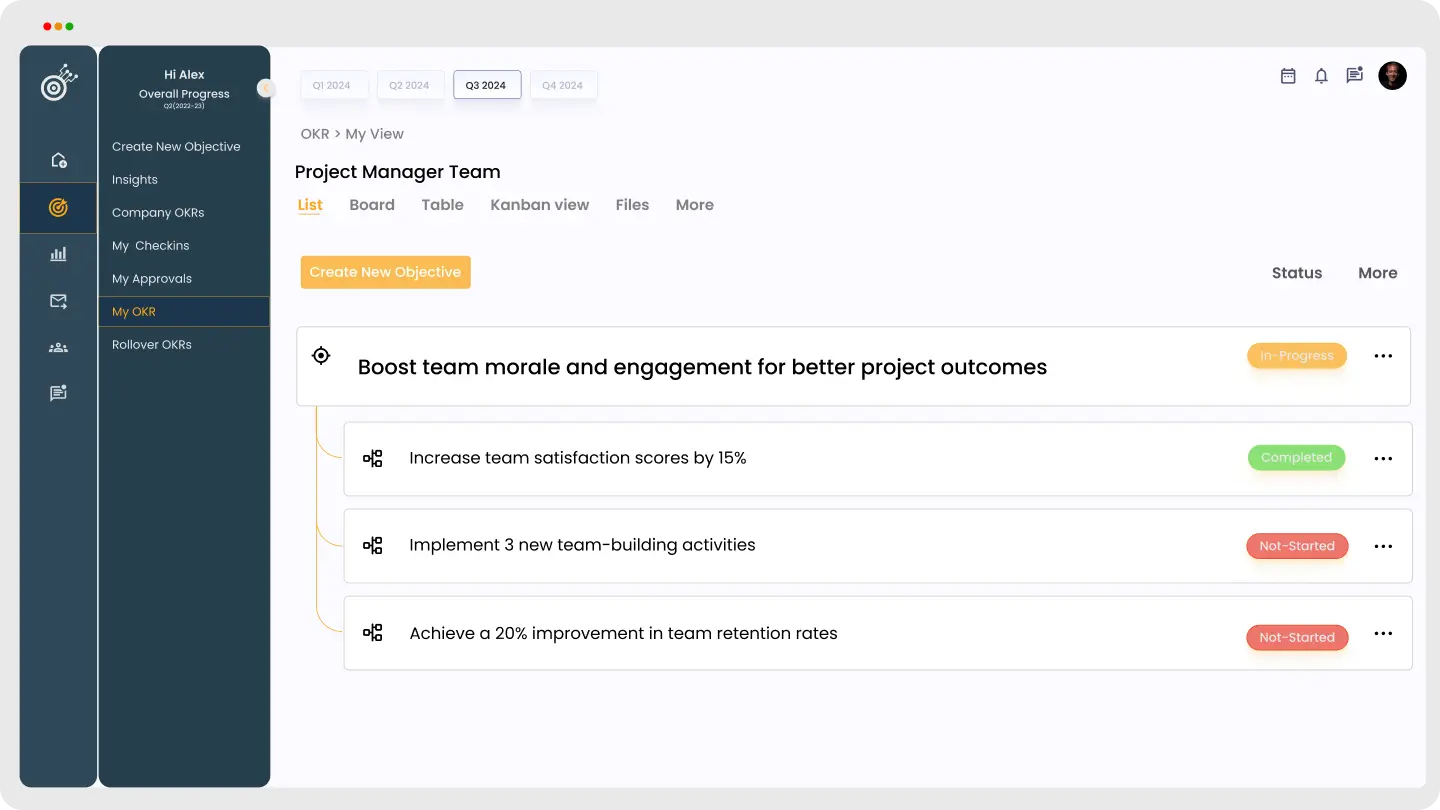
Improving team morale involves increasing satisfaction and engagement, which can be achieved through targeted team-building activities. Higher morale can lead to better project outcomes and reduced turnover.
Optimizing Project Costs
Objective: Reduce project costs while maintaining quality
- Key Results 1: Achieve a 10% reduction in overall project costs
- Key Results 2: Increase cost-saving initiatives by 25%
- Key Results 3: Maintain quality standards within budget constraints 90% of the time
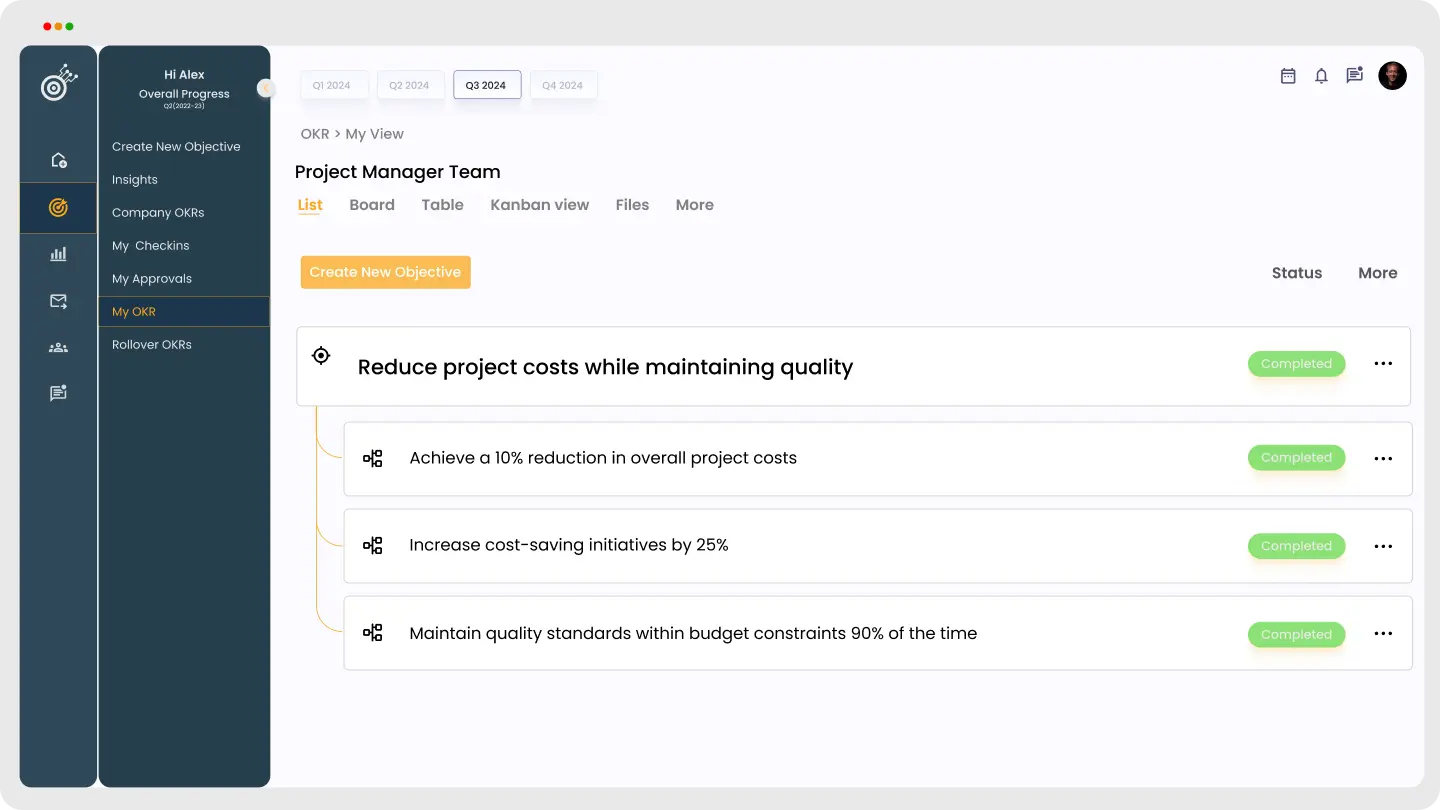
This involves finding ways to cut costs without compromising on the quality of deliverables. Effective cost-saving measures and stringent quality control can help achieve this balance.
Improving Project Forecasting
Objective: Enhance accuracy in project forecasting and budgeting
- Key Results 1: Increase forecasting accuracy to within 10% of actual costs
- Key Results 2: Reduce budget variances by 20%
- Key Results 3: Implement a new forecasting tool or process for 50% of projects
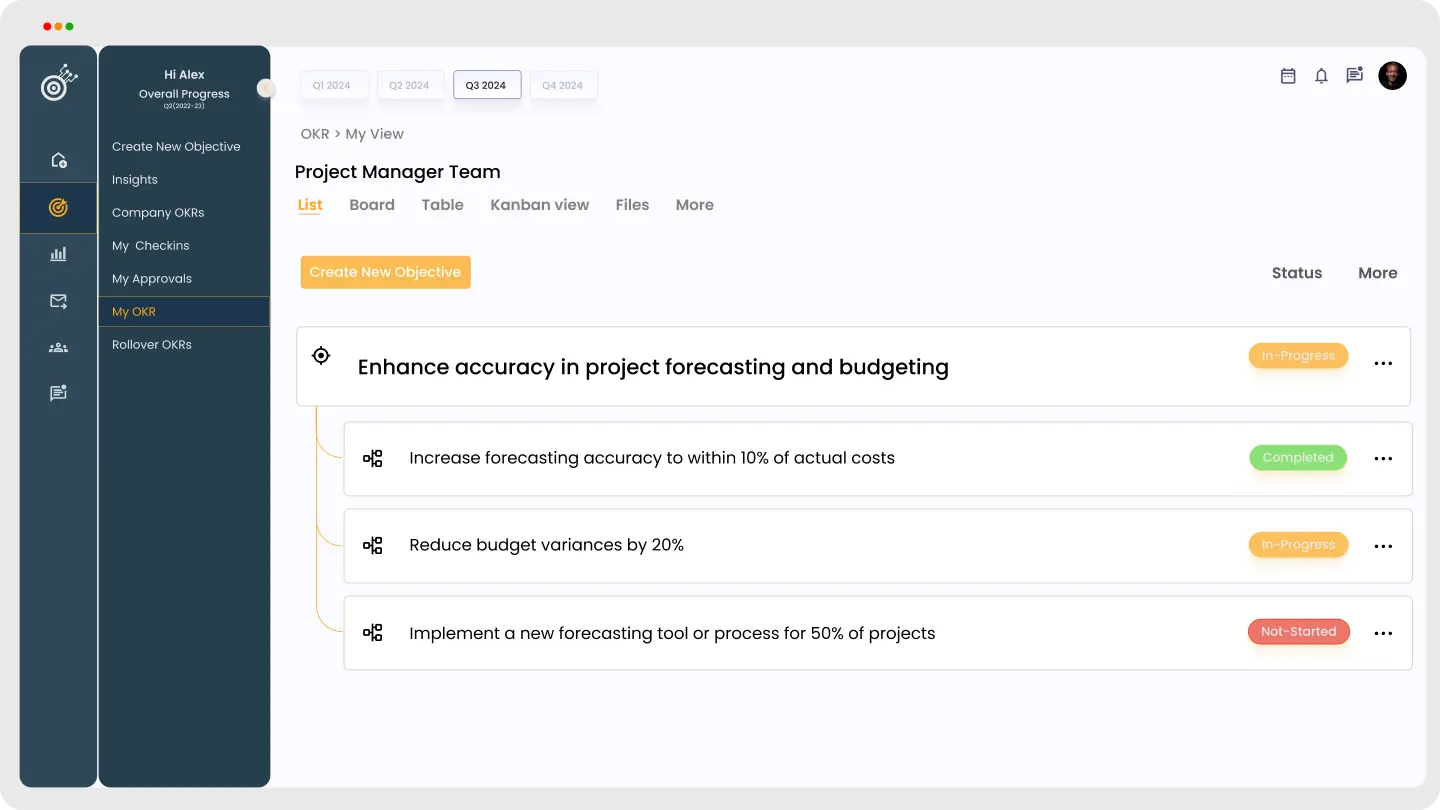
Better forecasting accuracy helps in more reliable budgeting and financial planning. Using new tools and processes can significantly reduce discrepancies between projected and actual costs.
Advancing Project Stakeholder Relationships
Objective: Strengthen relationships with key stakeholders
- Key Results 1: Increase positive stakeholder feedback by 15%
- Key Results 2: Conduct stakeholder engagement activities with a 60% participation rate
- Key Results 3: Resolve stakeholder issues or concerns within 7 days

Building stronger stakeholder relationships involves increasing positive feedback and actively engaging stakeholders. Promptly addressing their concerns can enhance overall project success.
Improving Project Risk Response
Objective: Enhance responsiveness to project risks and issues
- Key Results 1: Decrease response time to high-priority risks by 25%
- Key Results 2: Implement risk response plans for 80% of identified risks
- Key Results 3: Achieve a 30% reduction in risk impact on project outcomes
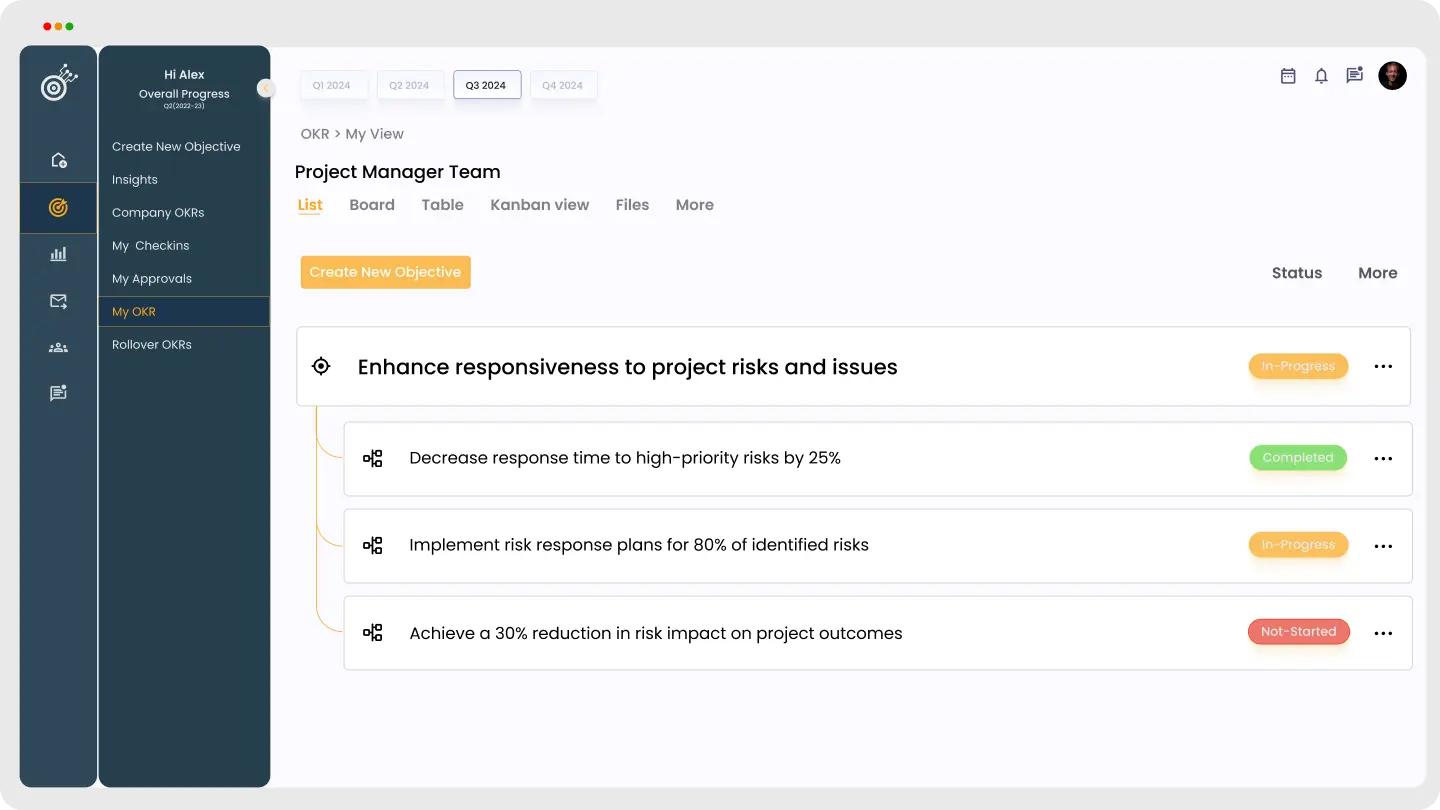
Improving risk response involves faster identification and management of high-priority risks. Effective risk plans and quick resolution of issues can minimize their impact on project outcomes.
Conclusion
To implement OKRs that drive project success, explore how Datalligence’s OKR Management Tool can help you set and track objectives, improve processes, and achieve remarkable results. Start your journey to project management excellence today!
To take your project management to the next level, consider leveraging Datalligence.AI’s advanced solutions. Our tools can help you implement and track OKRs, optimize processes, and make data-driven decisions. To explore how Datalligence.AI can boost your project management success, schedule a demo today. Remember, the journey to project management excellence is ongoing, and with the right strategies and tools, you can continuously improve and achieve remarkable results.

